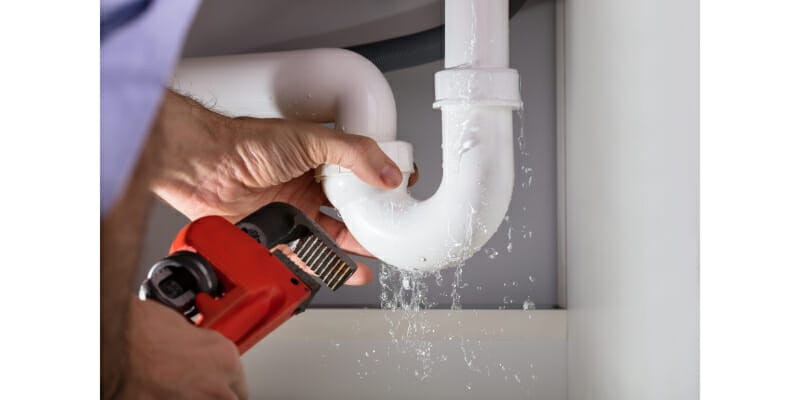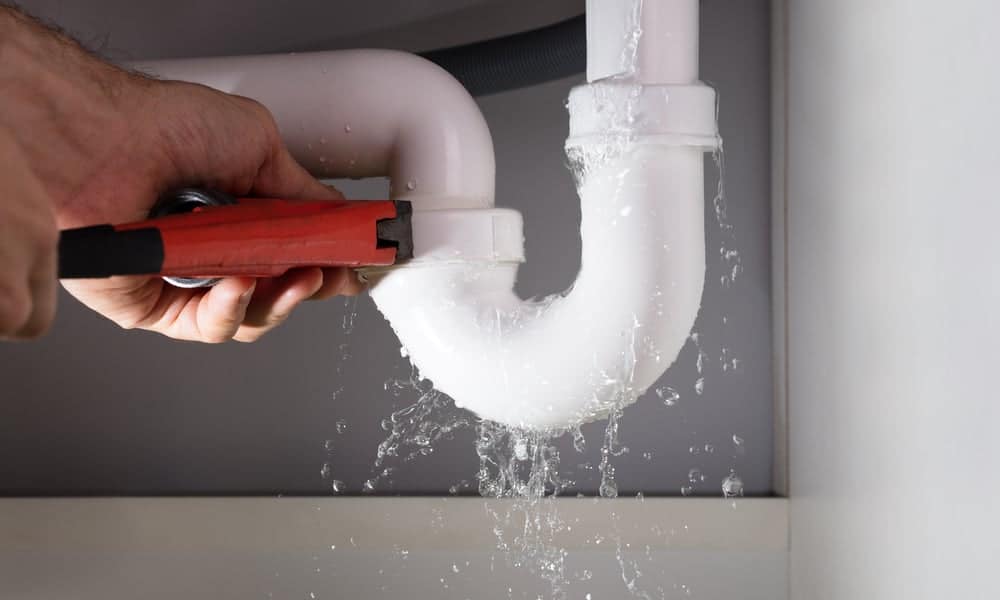If you've noticed a puddle of water forming under your bathroom sink, chances are you have a leaky pipe. Not only can this be a nuisance, but it can also lead to water damage and mold growth if left untreated. But don't worry, fixing a leaky bathroom sink pipe is a simple task that you can do yourself with a few basic tools.Fixing a Leaky Bathroom Sink Pipe
The first step in repairing a leaky bathroom sink pipe is to identify where the leak is coming from. Inspect the pipes under your sink and look for any water droplets or moisture. Once you have located the source of the leak, turn off the water supply to the sink. You can usually find the shut-off valve under the sink or near the main water supply for your house. Next, use a wrench to loosen the connections on either side of the leaky pipe. Carefully remove the pipe and inspect it for any cracks, holes, or other damage. If the damage is minor, you may be able to fix it with some plumber's tape. Simply wrap the tape tightly around the damaged area and reattach the pipe. If the damage is more significant, you may need to replace the pipe altogether. In this case, take the damaged pipe to your local hardware store to find a suitable replacement. Once you have a new pipe, attach it to the connections using a wrench and turn the water supply back on. Run water through the sink and check for any leaks. If everything looks good, you have successfully repaired your leaky bathroom sink pipe!How to Repair a Leaking Bathroom Sink Pipe
Fixing a leaking bathroom sink pipe is just one part of a larger leak repair process. If you have a leaky pipe, it's important to act quickly to prevent any further damage. Here is a step-by-step guide to help you through the repair process: Step 1: Turn off the water supply to the sink. Step 2: Identify the source of the leak and inspect the damaged pipe. Step 3: Attempt to fix the damage with plumber's tape or replace the pipe if necessary. Step 4: Turn the water supply back on and check for any leaks. Step 5: If the leak persists, it may be a sign of a bigger issue. Contact a professional plumber for further assistance.Bathroom Sink Pipe Leak Repair Guide
If you're a handy person who likes to tackle household projects on your own, fixing a leaky bathroom sink pipe is a task that you can easily handle. With the right tools and materials, you can save money by doing the repair yourself. Just be sure to follow the steps outlined in this guide and take your time to ensure the repair is done correctly.DIY Bathroom Sink Pipe Leak Fix
Now that you know how to fix a leaky bathroom sink pipe, it's important to understand what may have caused the leak in the first place. Some common causes of bathroom sink pipe leaks include: Age and wear: Over time, pipes can deteriorate and develop cracks or holes, leading to leaks. Loose connections: If the connections between pipes are not tight enough, water can seep out and cause leaks. Corrosion: If your pipes are made of metal, they can corrode over time, causing leaks and other issues. High water pressure: Excessively high water pressure can put stress on pipes and cause them to leak.Common Causes of Bathroom Sink Pipe Leaks
The best way to deal with bathroom sink pipe leaks is to prevent them from happening in the first place. Here are a few tips to help you avoid future leaks: Regular maintenance: Inspect your pipes periodically for any signs of damage or wear and tear. This can help you catch any potential issues before they turn into leaks. Proper installation: If you're installing a new sink or making any changes to your plumbing, make sure to do it correctly to avoid future problems. Reduce water pressure: If you have excessively high water pressure, consider installing a pressure regulator to help prevent stress on your pipes. Use caution: Be careful when using harsh chemicals or drain cleaners, as they can damage your pipes and cause leaks.Preventing Bathroom Sink Pipe Leaks
In some cases, a bathroom sink pipe leak may not be immediately noticeable. Here are a few tips to help you detect a leak: Check for water damage: Look for any water stains or discoloration on the floor or walls near the sink. Listen for dripping sounds: If you hear a constant dripping sound coming from under your sink, it may be a sign of a leak. Feel for moisture: Run your hand along the pipes under your sink to feel for any moisture or water droplets. Use food coloring: Add a few drops of food coloring to the water in your sink. If the colored water appears in the pipes under your sink, it's a sign of a leak.Bathroom Sink Pipe Leak Detection Tips
If you're not comfortable or confident in your plumbing skills, it's best to leave bathroom sink pipe leak repairs to the professionals. A licensed plumber has the knowledge and experience to efficiently and effectively fix any leaks in your bathroom sink pipes. They can also identify any underlying issues that may be causing the leak and address them to prevent future problems.Professional Bathroom Sink Pipe Leak Repair Services
In some cases, the damage to a bathroom sink pipe may be severe enough that it needs to be replaced. This is especially true for older pipes that may have multiple cracks or holes. If you are unsure about how to replace a pipe, it's best to consult a professional plumber to ensure the job is done correctly.Replacing a Leaky Bathroom Sink Pipe
It's important to be aware of the signs of a leaking bathroom sink pipe so you can catch and address the issue as soon as possible. Some common signs of a leak include: Puddles of water: If you notice water pooling under your sink, it's likely a sign of a leaky pipe. Musty odors: If water has been leaking for a while, it can lead to mold growth, which can cause a musty smell in your bathroom. Increased water bill: If you notice a sudden increase in your water bill, it may be a sign of a hidden leak in your bathroom sink pipes.Signs of a Leaking Bathroom Sink Pipe
How to Properly Fix a Leaking Bathroom Sink Pipe

Don't Let a Leaking Pipe Ruin Your Bathroom Design
 If you notice a puddle of water forming under your bathroom sink, chances are you have a leaking pipe. This not only causes damage to your bathroom design, but it can also lead to higher water bills and potential mold growth. It's important to address a leaking bathroom sink pipe as soon as possible to prevent further damage. Here are some steps to properly fix a leaking bathroom sink pipe.
If you notice a puddle of water forming under your bathroom sink, chances are you have a leaking pipe. This not only causes damage to your bathroom design, but it can also lead to higher water bills and potential mold growth. It's important to address a leaking bathroom sink pipe as soon as possible to prevent further damage. Here are some steps to properly fix a leaking bathroom sink pipe.
Step 1: Identify the Source of the Leak
 The first step in fixing a leaking bathroom sink pipe is to identify where the leak is coming from. Check the pipes underneath the sink, as well as the joints and connections. If you notice any water dripping or moisture, that is likely where the leak is located. It's important to also check the surrounding area for any signs of water damage or mold growth.
The first step in fixing a leaking bathroom sink pipe is to identify where the leak is coming from. Check the pipes underneath the sink, as well as the joints and connections. If you notice any water dripping or moisture, that is likely where the leak is located. It's important to also check the surrounding area for any signs of water damage or mold growth.
Step 2: Turn off the Water Supply
 Before you begin any repairs, make sure to turn off the water supply to the sink. This will prevent any water from leaking while you work and ensure your safety. You can usually find the shut-off valve under the sink or near the main water supply for your house.
Before you begin any repairs, make sure to turn off the water supply to the sink. This will prevent any water from leaking while you work and ensure your safety. You can usually find the shut-off valve under the sink or near the main water supply for your house.
Step 3: Tighten Loose Connections
 In some cases, a leaking bathroom sink pipe can be easily fixed by simply tightening any loose connections. Use a pipe wrench to tighten the nuts and bolts on the pipes and joints. Be careful not to over-tighten, as this can cause damage to the pipes.
In some cases, a leaking bathroom sink pipe can be easily fixed by simply tightening any loose connections. Use a pipe wrench to tighten the nuts and bolts on the pipes and joints. Be careful not to over-tighten, as this can cause damage to the pipes.
Step 4: Replace Damaged Parts
 If tightening the connections does not stop the leak, you may need to replace damaged parts. This could include a cracked or corroded pipe, a worn out washer, or a faulty valve. Make sure to turn off the water supply again before replacing any parts.
If tightening the connections does not stop the leak, you may need to replace damaged parts. This could include a cracked or corroded pipe, a worn out washer, or a faulty valve. Make sure to turn off the water supply again before replacing any parts.
Step 5: Use Plumbers Tape or Sealant
 Plumbers tape or sealant can be used as a temporary fix for minor leaks. Wrap the tape around the leaking area or apply the sealant to the joints. This will help prevent any further leaking until you can replace the damaged parts.
Plumbers tape or sealant can be used as a temporary fix for minor leaks. Wrap the tape around the leaking area or apply the sealant to the joints. This will help prevent any further leaking until you can replace the damaged parts.
Step 6: Call a Professional
 If you are not comfortable or experienced in fixing plumbing issues, it's best to call a professional plumber. They have the necessary tools and expertise to properly fix a leaking bathroom sink pipe and ensure it is done correctly.
Remember, it's important to address a leaking bathroom sink pipe as soon as possible to prevent further damage and maintain the integrity of your house design. By following these steps and seeking professional help when needed, you can successfully fix a leaking pipe and keep your bathroom in top condition.
If you are not comfortable or experienced in fixing plumbing issues, it's best to call a professional plumber. They have the necessary tools and expertise to properly fix a leaking bathroom sink pipe and ensure it is done correctly.
Remember, it's important to address a leaking bathroom sink pipe as soon as possible to prevent further damage and maintain the integrity of your house design. By following these steps and seeking professional help when needed, you can successfully fix a leaking pipe and keep your bathroom in top condition.














































:max_bytes(150000):strip_icc()/Leakingpipe-GettyImages-921346082-fb92dca8462e4f70a93b42b5ecd4913a.jpg)






















